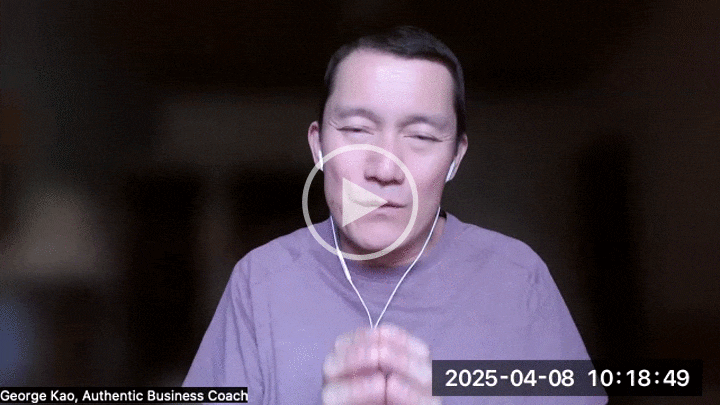- Orientation
- BizPlan
- BizPlan25
- Authentic Speaking
- Authentic Market Discovery
- Create Aligned Offers
- Joyful Productivity (Course)
- ✨ Authentic Outreach (AO)
- Joyful Pro
- Blog-to-Book
- 🚀 Course Creators
- 🖼️ Your Signature Framework
- 🙋 Effortless Yes
- 🌈 Energy Signature
- Meta Ads (FB / IG Advertising)
- 📱 Instagram Mastery
- 🎤️ Interview Mastery
- Launch Your Group Program
- Netcaring
- 🦸🏽✍🏽 Soulful Content (OGI)
- Substack Course
- "What do you do?"
- 🎬 YouTube Mastery

My journey began when I realized how deeply triggered I could get by my own children. I noticed that my inner emotional response was often way out of proportion to what was actually happening — and I couldn’t “think” my way out of it. Then I read that 95% of our actions come from the subconscious mind. That one insight sent me on a deep dive inward.
From that moment, the journey unfolded. I explored the inner child, limiting beliefs, ego patterns, mindfulness, body awareness, and the stories we tell ourselves. I started practicing breathwork, meditation, and intention setting. I learned to connect with my higher self, strengthen my intuition, and open to higher and even cosmic consciousness.
I’ve been landing deeper and deeper into myself — and into life. And this process is never finished (thankfully).
But it has already brought me so much, that I now feel it’s my mission to guide others in their own inner journey. With heart, and soul.
My journey began when I realized how deeply triggered I could get by my own children. I noticed that my inner emotional response was often way out of proportion to what was actually happening — and I couldn’t “think” my way out of it. Then I read that 95% of our actions come from the subconscious mi…
 6:48
6:48
Learn & Work Lightly ✨ Paper Airplane Mindset
Welcome to Module 2! Before we dive into the practical aspects of course creation, we need to talk about mindset... adopting a light, experimental approach that will prevent overwhelm and encourage consistent action. The Challenge of Overthinking Many aspiring course creators get stuck in the planning and preparation phase. They feel like they need to have everything perfect before they can launch. A student in this course perfectly captured this common feeling: "Do you have recommendations about how to keep the steps small enough? And how do you stay loose and not too attached to specific ideas as you are going about the development process?" The answer is in embracing an iterative mindset. Work Lightly ✨ Learn Lightly ✨ The core principle we'll be emphasizing throughout this course is to work lightly and learn lightly. This means: Taking small, manageable steps. Don't try to do everything at once. Break down the process into bite-sized actions for yourself. Embracing imperfection. Your first course (or even your tenth!) won't be perfect, and that's okay. The goal is to get it out there, learn from the experience, and improve over time. Being flexible and adaptable. Be willing to adjust your plans based on feedback and results. Don't get too attached to any single idea. Prioritizing action over endless planning. The best way to learn is by doing. Don't get stuck in "analysis paralysis." Take on an iterative mindset. The "paper airplane" analogy might help. The Paper Airplane Analogy: Think about creating a paper airplane. You fold a piece of paper, give it a toss, and see how it flies. It might nosedive, veer off course, or maybe even fly surprisingly well. Do you give up and declare yourself a failure if the first flight isn't perfect? Of course not! You pick up the airplane, make adjustments (bend a wing, straighten the nose), and try again. You learn from each flight, making small tweaks until the airplane flies better and better. This is an iterative mindset. Your courses are similar. They're not quite as inconsequential as paper airplanes, but in the grand scheme of your business, each individual course launch is definitely an experiment. The faster you launch, get feedback, and iterate, the faster you'll improve and create truly impactful courses. Journaling Exercise: Take a few minutes to journal about the experimentation mindset. What does it mean to you to "work lightly and learn lightly", and to take on an iterative mindset? How might adopting this mindset change your approach to course creation? Write whatever comes to mind – there are no right or wrong answers. Share your responses below as a comment if you'd like!
 6:18
6:18
Why bother? I have such a small audience I can't enroll anyone...
A common, very understandable fear when thinking about creating courses is: "What if I pour my heart and soul into creating this course, launch it, and no one (or almost no one) signs up? Especially if I have a small audience?" This fear stops many talented creators before they even start... That's why I practice and recommend a "Launch Lightly" approach – essentially, launching your course offer before you've created all the course content. The Strategy: Launch First, Create Content Week-by-Week Instead of spending weeks or months creating all the modules of your course upfront, focus first on: Defining the Offer: Get clear on the topic, draft an outline (like we'll do later, in Modules 2 and 3), write the description, choose a title, set a price. Setting up the Launch: Create the registration page for your FTA webinar (we'll talk about this strategy later in this module) and the sales page for the full course. Launching Gently: Announce your FTA webinar and open registration for the full course. We'll work on this in Modules 3 and 4. You only need to have the introductory content of your course -- your FTA webinar -- ready before that first session. You then create the content for Modules 2, 3, 4, etc., week-by-week, after you've confirmed you have enough enrollment to run the course. Why This "Launch Light" Strategy Works Wonders: It forces you to organize your ideas: Every time you attempt to launch a course, you will create an outline and description, which requires you to structure your expertise into a presentable package. This is valuable work in itself! It instantly boosts your credibility: Simply announcing a planned course will help to position you as an expert who has something valuable to offer. Even if this specific launch doesn't result in a course running this time, your audience sees you developing and offering valuable knowledge. (And honestly, social media moves so fast, few will remember the specifics if you launch something different a few weeks later!) You practice gentle launching: Every time you put an offer out there, you practice the skills of authentic marketing and communication. You build resilience and speed in your actions for the next launch. It minimizes wasted effort: This is key! You avoid spending potentially dozens of hours creating content for Modules 2-6 before validating that there's enough market interest right now. Handling Low Enrollment Gracefully (It's Okay!) So, what do you do if only one or two people sign up, or not enough to create the group dynamic you envisioned? It's simple, low-stress, and builds trust: Option 1: Offer Alternatives: Reach out personally to the few who enrolled. Explain honestly that enrollment didn't meet the minimum for the group experience you intended. Offer to convert their payment into credit towards 1:1 coaching/consulting with you, or perhaps credit towards a different offering. You could also mention that if you run the course in the future, they'll get access then. Most people are very understanding. Option 2: Offer Full Refunds: Simply thank them for their interest, explain the situation, and issue a prompt, full refund. No harm done! People respect honesty and clear communication. In either case, the "failed" launch isn't a failure at all – it's valuable market feedback, gathered with minimal risk to your time and energy. Embrace the Experiment! This "launch lightly" approach removes one of the biggest mental barriers to getting started. It allows you to test ideas, practice launching, and build momentum without the fear of wasting huge amounts of effort upfront. Reflection: Take a moment to consider: How does knowing you don't have to create all the content before launching change your feelings about creating your first (or next) course? Does it feel lighter or more doable? Feel free to share a brief reflection in the comments if you like.
- Summarize this thread
- Copy link
This kind of "self belitteling" is very common and I can definetely relate to it...like "who am I to...?" and then make the mindset shift to "who am I NOT to...?". Always bother!! I like how you help us focus on the small wins instead of only seeing what's not working, who's not signing up etc. Even if you get none or just a few sign-ups you have learned, evolved...and like...celebrate that! And with time and when doing it over and over again you will get there!! Jut don't give up! No matter what!
- Summarize this thread
- Copy link
Thanks Mats! 🙏🏼
- Summarize this thread
- Copy link
@Mats Törnvall Thank you for adding these wise words!
- Summarize this thread
- Copy link
That definitely feels lighter and more accessible. And maybe hosting that first webinar with just two people isn’t such a bad idea—it allows you to find out what questions are coming up.
 4:26
4:26
Who "should" be creating courses? Don't we need an audience first?
"What if this is my first offering as a creator? Should people just entering the content creation field start elsewhere?" This is a fantastic question that many aspiring course creators grapple with. The short answer is: No, you don't need a large, established audience to successfully create and launch a course. In fact, creating a well-crafted course can be one of the fastest ways to build your audience and establish yourself as an expert in your field. The Power of Courses for New Creators: The beauty of courses, especially shorter courses or even a single, well-focused webinar, lies in their ability to: Showcase Your Expertise: A course allows you to demonstrate your knowledge and passion in a structured, in-depth way that goes far beyond a blog post or social media update. It positions you as a go-to resource. Provide Tangible Value: Students are actively seeking solutions and transformation. A well-designed course offers that, making it inherently valuable and attractive. Accelerate Audience Growth: When your course is aligned with what people want and need, and it's delivered well, it can be a highly effective tool for word-of-mouth audience growth. Build Authority Quickly: Successfully teaching a course, even a small one, establishes credibility and positions you as an authority in your niche. My Personal Story and Strategy: I (George Kao) actually started my online business by creating courses right from the start. I didn't have a large following. Here's the strategy I used, and it's one you can adapt, starting with the people you already know: Identify Your Expertise & Passion: What are you genuinely knowledgeable and passionate about? What problems can you solve for others? This is the foundation of your courses. Identify "Influencers" (Within Your Network): Look at the people already in your network. This includes: Facebook friends LinkedIn connections People who follow you on Instagram (or other social media) Contacts in your cell phone address book Email contacts People you've met at networking events or conferences Colleagues past and present Clients past and present Are there friends, colleagues, or acquaintances who have a network or audience that would benefit from your course topic? These could be bloggers, authors, podcasters, service providers, other course creators with a complementary offering, or even just individuals with a bit of a following. Think broadly – "influence" doesn't always mean having a massive following. It can mean having a small but highly relevant following. Offer Genuine Help: Approach these individuals and offer to help them personally (for free) with the topic of your course. This isn't a sales pitch; it's a genuine offer of value, leveraging your existing connection. You might say something like, "Hey [Name], I know you're interested in [Topic]. I've been developing some expertise in this area, and I'd love to offer you a free consultation/mini-training/resource to help you with [Specific Problem]." Build (or Strengthen) Relationships: By providing valuable assistance, you build (or deepen) trust and rapport with these individuals. Strategic Collaboration: After you've provided value and established a stronger connection, you can then explore the possibility of them sharing your course with their audience. This is much more effective than a cold outreach because it's built on a foundation of genuine help and a pre-existing relationship. Key Takeaway: Don't let the lack of a large audience hold you back. A well-crafted course, combined with a strategic approach to leveraging your existing network, can be a powerful engine for growth. We will be diving a lot more deeply into the above strategy, and working on the specifics, in the coming modules of this course. Revisiting Lesson 1: Think back to the qualities of an effective course creator we discussed in Lesson 1. Do you want to embody those qualities more fully? If so, creating courses is not just a business strategy; it's a path to personal and professional development. Action Step: Start brainstorming a list of people in your existing network who might be a good fit for the "influencer" strategy described above. Consider who has a relevant audience and who you could genuinely help. Comment below on whether you have ever thought of this strategy, or how you might now use it. Also comment on any connections that came to mind!
- Summarize this thread
- Copy link
This sounds like a good strategy! It definitely gives me some food for thought. No one comes to mind right away, but I’m setting the intention for this to come to me!




Less perfectionism! Focus less on fixing what's broken and more on creating new things. Regularly check in with myself: does this feel light or heavy? Less overthinking. Less preparing for every possible scenario. More trial and error, developing as I go.